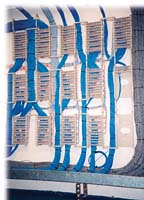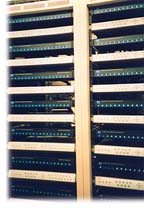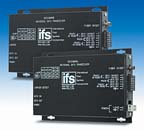Fiber, Coax or UTP?
If cable runs less than 250 feet, coax is probably the best option. Between 250 and 8,000 feet, UTP wire is often the best choice. If the runs are more than 8,000 feet, it’s time to consider fiber. Other conditions that may indicate UTP wire include runs between buildings and floors, noisy environments, existing UTP wire, or the need for plenum cable or conduit. For companies using cameras with built-in UTP transmitters, pan, tilt and zoom (PTZ) cameras, or a DVR that is sensitive to attenuated video, UTP may be the transmission mode of choice.<

Considering cost
This is because UTP lets the end user share cable to reduce both labor and cable costs. Multiple pairs in a single cable can be used for video signals with control or video signals with 24VAC power. The end user can even share video with ringing telephones or data lines – all noise-free.With UTP, systems also can be designed to maximize cable usage. New on the market, and available from several different cable manufacturers, is a UTP composite cable, also known as a "Siamese" UTP cable.
Designed specifically for security video, this cable enables the installer to run video, power and PTZ control (RS-422 or RS-485) within a single bundle, either zipped or composite. Each cable bundle contains 16/2 or 18/2 for low-voltage power and two pairs of Cat-5e for video and PTZ control.
The end user should run this from each camera to a local wiring closet where the multi-port power supply and cross-connect punch blocks are located. The pairs for power are terminated at the power supply and the pairs for video and PTZ control get punched down to continue their path to the control end via a larger UTP backbone.
PTZ pairs may share the same punch block with the video pairs. In each case, at least one cable pull is eliminated. This time-proven design, used by telephone and data network systems for decades, allows for future expansion, fast moves and changes, plus forward compatibility with future all-digital solutions. If the camera requires PTZ control, it should be powered locally with data and video sent in the UTP bundle.
UTP wire is at least one-tenth the size of RG-59, costs about one-eighth for non-plenum and as little as one-thirtieth for plenum cable. The physical size of the cable makes it easier to pull. Termination is much simpler than coax because no crimping is involved. Wire pairs are easily identified by their different colors. Surge protection, ground loop isolation, distance equalization and interference immunity are each superior to that of coax.
At short distances, however, the cost of the UTP transceivers becomes a factor. Typically, coax costs less for small camera counts on non-plenum wire that is less than 250 feet in length. In most other cases, UTP is more economical.
End users with a plenum environment also can benefit from UTP, as the cable is jacketed with two types of material: PVC, a low-grade plastic, and plenum, which is fire-rated Teflon. PVC coax costs up to 50 percent less than plenum coax, which is required by most fire codes for ceiling and in-wall wiring in commercial buildings.
As the number of coax cables needed increases, each extra coax adds its own plenum jacket, while UTP can have up to 100 UTP pairs under one plenum jacket. Savings on the wire and the labor to pull it really add up as the number of required pairs increase.

Comparing UTP to fiber
UTP transmission is significantly less costly than fiber, from cable and installation costs to tooling and transceivers. The most important comparison, however, is that of quality. Passive to active UTP systems offer performance similar to fiber, providing noise immunity, attenuation compensation, surge protection and ground loop isolation. Because of this, some who once used fiber for runs beyond the range of coax now choose UTP for transmission. Fiber is good for extremely long runs (over one mile) or for safety when video is run in the same conduit with high voltage.
UTP security video transmission offers state-of-the-art technology with features and benefits beyond those of coax. No longer constrained by the size of bulky coax or the high cost of fiber, one can design truly integrated, future-proof systems.

Sidebar: A Diversity of Analog, Digital Fiber Transmission
Security use of fiber optic transmission continues to expand. One firm, International Fiber Systems IFS of Newtown, Conn., for example, offers more than 300 analog and digital fiber optic transmission products for use in transmitting video, audio, and data signals over optical fiber.But at a recent International Security Conference, IFS introduced a Video Over UTP Solution, too. The IFS Copperline TPT1000M and TPR1000 are environmentally hardened UTP video transmitter and receiver systems.
According to security specifiers, many buyers saw the choice of security video transmission as limited to optical fiber, coaxial cable or UTP, with UTP having the lowest price, but sometimes challenging video performance.
"Most UTP transmission products had their signal attenuated at about a thousand feet, making the picture unrecognizable." said Steve Rutkowski of IFS. Now there is a way to match analog video signal impedance of the transmitter and receiver and effectively boost transmission distances up to a half mile through products such as Copperline. It’s said to deliver EIA/TIA RS250-C medium haul video performance at 1,500 ft and beyond.
Another source, Menlo Park, Calif.-based Network Video Technologies’ UTP CCTV transceiver, the NV-214A-M, has a 9-inch mini-coax pigtail lead that allows in-camera enclosure mounting in most dome cameras and a greater number of mounting options at both ends of the system.
The fiber side of security video continues strong, too.
IFS, for instance, serves applications transmitting security video, access control, fire and alarm signals over optical fiber. Pictured above: Faster fiber, IFS D2510WDM Series Universal Serial Data transceiver supports rates up to 512kbps.
Looking for a reprint of this article?
From high-res PDFs to custom plaques, order your copy today!


